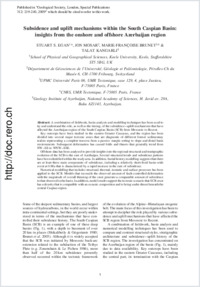Subsidence and uplift mechanisms within the South Caspian Basin: insights from the onshore and offshore Azerbaijan region
- Egan, Stuart S. School of Physical and Geographical Sciences, Keele University, Keele, Staffordshire UK
- Mosar, Jon Département de Géosciences de l'Université de Fribourg, Géologie et Paléontologie, Switzerland
- Brunet, Marie-Françoise UPMC Université Paris 06, UMR Tectonique, France - CNRS, UMR Tectonique, Paris, France
- Kangarli, Talat Geology Institute of Azerbaijan, National Academy of Sciences, Baku, Azerbaijan
-
2009
Published in:
- Geological Society, London, Special Publications. - 2009, vol. 312, p. 219-240
English
A combination of fieldwork, basin analysis and modelling techniques has been used to try and understand the role, as well as the timing, of the subsidence–uplift mechanisms that have affected the Azerbaijan region of the South Caspian Basin (SCB) from Mesozoic to Recent.Key outcrops have been studied in the eastern Greater Caucasus, and the region has been divided into several major tectonic zones that are diagnostic of different former sedimentary realms representing a complete traverse from a passive margin setting to slope and distal basin environments. Subsequent deformation has caused folds and thrusts that generally trend from NW–SE to WNW–ESE.Offshore data has been analysed to provide insights into the regional structural and stratigraphic evolution of the SCB to the east of Azerbaijan. Several structural trends and subsidence patterns have been identified within the study area. In addition, burial history modelling suggests that there are at least three main components of subsidence, including a relatively short-lived basin-wide event at 6 Ma that is characterized by a rapid increase in the rate of subsidence.Numerical modelling that includes structural, thermal, isostatic and surface processes has been applied to the SCB. Models that reconcile the observed amount of fault-controlled deformation with the magnitude of overall thinning of the crust generate a comparable amount of subsidence to that observed in the basin. In addition, model results support the tectonic scenario that SCB crust has a density that is compatible with an oceanic composition and is being under-thrust beneath the central Caspian region.
- Faculty
- Faculté des sciences et de médecine
- Department
- Département de Géosciences
- Language
-
- English
- Classification
- Geology
- License
-
License undefined
- Identifiers
-
- RERO DOC 11825
- DOI 10.1144/SP312.11
- Persistent URL
- https://folia.unifr.ch/unifr/documents/301006
Statistics
Document views: 118
File downloads:
- pdf: 237
